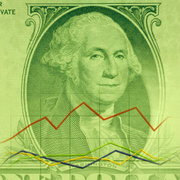Price, Utilization Increases Upped Healthcare Spending by 4.5%
A recent HCCI report found that rising prices as well as more outpatient and professional care utilization drove higher healthcare spending in 2015.

- Healthcare spending for privately insured individuals increased by 4.6 percent because of rising prices for outpatient, inpatient, and professional care services as well as prescription drugs, the Health Care Cost Institute (HCCI) recently reported.

HCCI researchers found that healthcare prices for outpatient, inpatient, professional care, and prescription drug services rose between 3.5 percent and nine percent in 2015, representing a greater increase in prices than in 2013 and 2014.
As a result, healthcare spending increased faster in 2015 compared to the last couple of years. Spending rose by just three percent in 2013 and 2.6 percent in 2014.
“Spending grew faster than we might have expected in 2015, given the low growth of previous years,” stated Amanda Frost, HCCI Senior Researcher. “The combination of people using more healthcare services and faster growth in prices pushed up spending, with prices playing the biggest role.”
Claims data from Aetna, Humana, Kaiser Permanente, and UnitedHealthcare from 2012 to 2015 showed that healthcare spending, including deductible, co-pay, and co-insurance expenditures, significantly increased in 2015.
Individuals younger than 65 and those covered by employer sponsored insurance saw the greatest increase in spending, the report added. Overall spending rose by $5,141 per person in 2015, while out-of-pocket spending on deductibles, co-pays, and co-insurance grew by three percent, an average $813 per capita.
Researchers also noted that individuals 45 years or older spent more than $1,000 in out-of-pocket expenses in 2015. Women also spent about $236 more in out-of-pocket expenses versus men.
The report also broke down healthcare spending by region. Of the 18 states studied, Washington DC had the lowest per capita out-of-pocket spending with an average of $636, followed by Maryland with $682.
On the other hand, the state with the highest overall out-of-pocket spending was Texas with an average of $983.
Researchers attributed greater healthcare spending in 2015 to a combination of rising healthcare prices and an increase in healthcare services utilization.
While prices for outpatient, inpatient, and professional healthcare services increased in 2015, the report found that prescription drug spending grew faster than all other areas. About $649 per capita was spent on brand name drugs in 2015, representing an 11.4 percent increase since 2014.
Hormone and anti-infective prescription drugs, including those used to treat hepatitis C and HIV, accounted for a significant portion of the spending, researchers added. Brand name anti-infective prescription drug prices almost doubled between 2012 and 2015, causing the average price per filled day to increase from $35 in 2012 to $83 in 2015.
The price growth for brand name anti-infective medications caused healthcare spending per capita to also double over the study period even though utilization decreased, researchers reported. The price jumped from $53 per person in 2012 to $101 per person in 2015.
Generic prescription drug spending also increased compared to last year. Healthcare spending on generic drugs was about $313 per person, a 3.3 percent boost from 2014.
However, the average price per filled day for generic prescription drugs ranged from $1 to $2. The price held steady for every year studied.
Other key price trends researchers found over the course of the study included:
• Emergency department visits prices rose by 10.5 percent to an average of $1,863
• Prices for provider-administered medications, including chemotherapy drugs, jumped by 12.5 percent to an average of $534
• Average acute hospital admission price rose by about $1,000 each year between 2012 and 2015, reaching $19,697 in 2015
Outpatient, inpatient, and professional healthcare services utilization also contributed to the uptick in healthcare spending in 2015, researchers added. Notably, outpatient care and professional services, such as physician visits and laboratory tests, modestly increased in the past year.
However, emergency department visits, common medical admissions, and surgical hospital admissions decreased in 2015. The use of these services has steadily declined over the past few years, the report noted.
In terms of prescription drug use, researchers found that generic prescriptions increased over the course of the study while brand name prescriptions declined, resulting in an overall decrease in prescription drug use.
Utilization trends also appeared across provider type. For example, office visits to specialists grew between 2012 and 2015, whereas primary care visits decreased each year since 2012.
“Using data from four of the nation's largest health insurers, we're able to look closely at the changes in healthcare use and prices over time to understand what is driving costs,” said David Newman, HCCI Executive Director. “Year after year we see one constant: Rising prices that are accelerating spending growth.”
In July, the CMS Office of Actuary reported similar healthcare spending growth rates. The federal agency projected that growth rate would be around 5.8 percent annually between 2015 and 2025.
According to an accompanying Health Affairs report, the key drivers behind rising healthcare spending included the aging population, coverage trends, and continuous increases in medical care prices.
“This faster trend is primarily the result of a projected gradual acceleration in medical price growth and the impact of increased demand for care in response, on a lagged basis, to accelerating growth in disposable personal income,” the report stated.
Dig Deeper:
• Key Ways to Boost Collection of Patient Financial Responsibility
• How to Bend Healthcare’s Cost Curve Over the Next Decade
